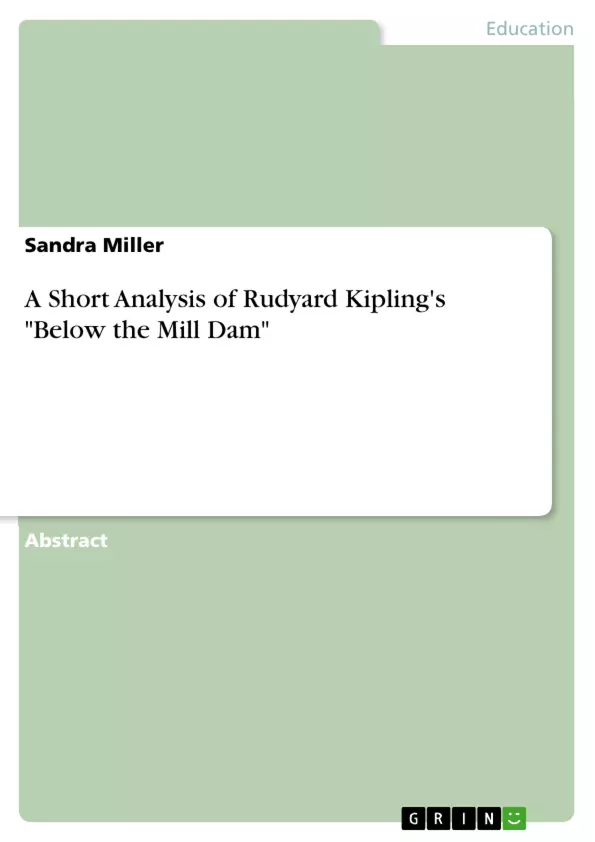“Below the Mill Dam” is set at Robert’s Mill in the English countryside at or about the time of the story’s publication (1902). Rudyard Kipling had just returned from Africa, where he had experienced the disastrous effects of the Boer War and witnessed such things as the British invention of concentration camps. He was alarmed by the ignorance of British politicians: “Conservative Balfour government’s dead cultured aristocratic hand barred the way to a wider, less class-ridden British Empire” (Wilson 226).
Kipling was pessimistic that Britain could uphold her imperial role as the world’s leading nation, moreover, he was “extremely uneasy with, and critical of, unquestioned traditions, ruling-class hierarchies, and complacent establishments” (Lee 12). Fairly late in his life, in 1902, Kipling decided to live in Sussex in England. Shortly after, he had electricity installed in his house - which was not common at that time - and a sign that he was generally interested in and fascinated by new technology; he installed a turbine, a generator and associated equipment in the watermill in his own garden.
Allegorical or symbolic tales, such as “Below the Mill Dam” convey Kipling's passion for machinery and technology. The story reflects Kipling’s views about the changing environment, political atmosphere and the technical innovations that were transforming industry and the modes of production in farming, their impact on the landscape and on living conditions. Kipling disguised his plot as a fable, probably to avoid resentment from the establishment. In writing a political fable, he was able to express his “alarm and dismay at England’s apparent inability to address herself socially, imperially, culturally and technologically to the future” (Page 69). Kipling uses allegorical language throughout the dialogues as a means of mockery and satire about forces which want to preserve tradition against the new emerging forces that are pressing for change and development.
Inhaltsverzeichnis (Table of Contents)
- A Short Analysis of Rudyard Kipling's story "Below the Mill Dam"
Zielsetzung und Themenschwerpunkte (Objectives and Key Themes)
This analysis aims to explore the allegorical themes and messages embedded within Rudyard Kipling's short story "Below the Mill Dam." The story, set in the English countryside during the early 1900s, utilizes personified animal characters and inanimate objects to represent various social classes and their attitudes towards technological innovation and societal change.
- The conflict between tradition and progress
- The changing social landscape of England
- The impact of technology on society and the environment
- Social class dynamics and the roles of different groups in society
- The inevitability of change and the need for adaptability
Zusammenfassung der Kapitel (Chapter Summaries)
The story unfolds through a series of dialogues between the personified characters: the Grey Cat and the Black Rat, representing the upper classes; the Waters, symbolizing progress and technological innovation; the Wheel, embodying tradition and clinging to the past; and the Millstones, representing the working class. Through these interactions, Kipling satirizes the resistance to change among the traditional elite and champions the embrace of new technologies.
The Waters, representing the forward-thinking forces, challenge the old Wheel, which is slow and resistant to change. Their dynamic represents the clash between the old and new ways of life, with the Waters pushing for progress and efficiency. The Grey Cat, representing the decadent English gentry, and the Black Rat, representing the complacent 'Old English Officer class,' both cling to their entrenched privileges and resist change. The Millstones, the working class, are shown as pragmatists, accepting the changes brought by the new technologies without engaging in the ideological struggle. This dynamic reveals Kipling's view of societal change, where progress is inevitable and those who resist it are doomed to become relics of the past.
Schlüsselwörter (Keywords)
Key themes and concepts explored in the story include tradition vs. progress, technological innovation, social class dynamics, allegory, satire, and the changing nature of British society at the turn of the 20th century. The story utilizes anthropomorphism, personification, and symbolic language to convey these themes and highlight the tension between the past and the future.
- Quote paper
- Dr Sandra Miller (Author), 2004, A Short Analysis of Rudyard Kipling's "Below the Mill Dam", Munich, GRIN Verlag, https://www.hausarbeiten.de/document/293526


